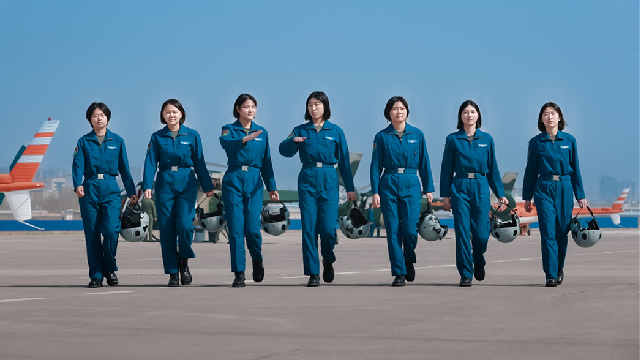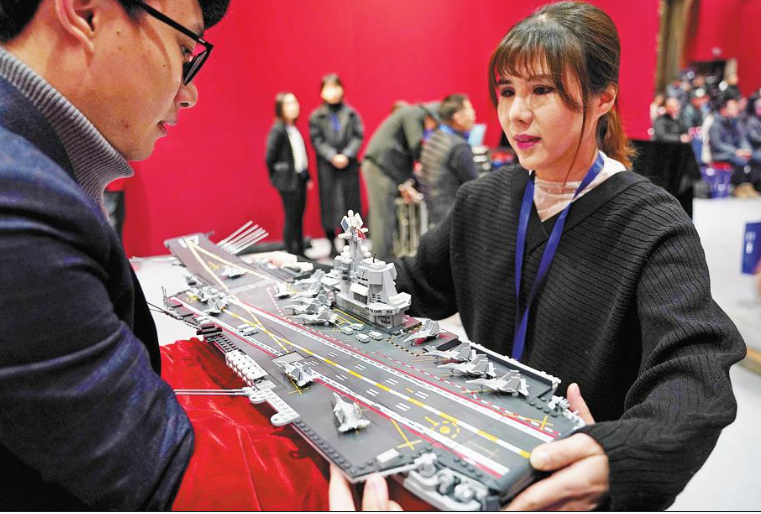
A building block model of the Shandong is unveiled on Jan 7 in Beijing. [Photo/China Daily]
The creative team that contributed to the logo and emblem of China's first home-built aircraft carrier has launched a range of products aimed at young consumers, Li Yingxue reports.
China's first fully homegrown aircraft carrier, the CNS Shandong, was delivered to the People's Liberation Army Navy at a port in Sanya, South China's Hainan province, on Dec 17.
Two weeks later in Beijing, a series of cultural and creative souvenirs and products related to the launch of the warship were unveiled, from emblemed badges and baseball caps to detailed models of the Shandong.
Xie Dahuan, chief designer of China Shipbuilding Culture and Technology Co, was tasked with heading a team to create the new emblem and logo for the ship back in 2017, and to develop a range of ancillary products that would appeal to younger Chinese consumers.
The 12 designers who joined Xie's team were all born in the 1980s and '90s.
Xie spent many sleepless nights in the run-up to creating the first draft of designs, and over the past two and a half years, Xie's team submitted a total of 28 designs for the ship's emblem and logo.
"Even though the 28 versions seemed to change a lot, we were glad that the overall design direction didn't really alter much from our first draft," Xie says.
"Some of our designers have grown from knowing nothing about the military to being able to tell the difference between every fighter plane and aircraft carrier,"Xie says."We were all very touched the day the Shandong was delivered to the navy."
According to Xie, the composition of the emblem shows planes taking off from the aircraft carrier out at sea, and the emblem has been designed in such a way that it can be seen on three levels from different distances.
"If you see emblem from 5 meters away, it conveys the momentum of the navy. If you are looking at it from just one meter away, you can tell it's the Shandong. But if you study the emblem even more closely, you pick out all the details in the design," Xie explains.
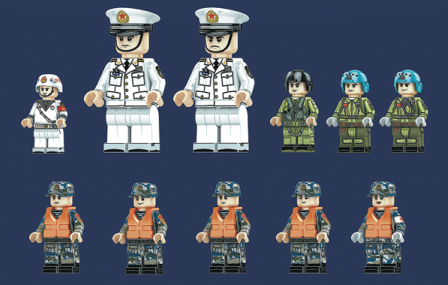
Some block figures representing different roles on the aircraft carrier. [Photo/China Daily]
The water motif below the Chinese characters "PLA Navy Shandong" originates from a pattern used in porcelain found in Shandong province that dates back to ancient times.
"The reason we put the water pattern on a ribbon is that we want to show that, even though the PLA Navy has a short history of 70 years, it's still part of China's 5,000-year-old culture," Xie explains.
To make sure each line of the drawing of the aircraft carrier on the emblem is exactly the same as the Shandong, Xie's team visited the vessel around a dozen times.
Compared to the emblem, which is bold and steadfast, the logo looks younger, more modern and dynamic-the wings of the eagle hold up the deck of the aircraft carrier.
Born and raised in Neijiang, Sichuan province, Xie has been a military buff since childhood.
He still remembers the day he stepped onto the Shandong for the first time. "My mind went blank for the first 10 minutes, and in my trance, I seemed to meet my 10-year-old self who told me that my dream of working with the army had finally come true by designing the emblem for the Shandong.
"Over the past two years, I've witnessed the Shandong moving closer to perfection. It's such a large ship that you could easily get lost on it."
There was one time when Xie visited the Shandong, when it was moored alongside the CNS Liaoning, China's first aircraft carrier."They looked so fantastic together, and they made me feel really small," he recalls.
Having graduated from Beihang University with a major in industrial design, Xie designed the trophy for the Red Star Design Award.
As a designer, he keeps to the rule that each piece of work he designs should be a masterpiece."The designer should always create work that comes from the soul. Without soul, your work will become an orphan, but if you do it properly, it will always stay attached to you."
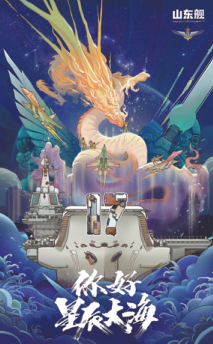
A poster that celebrates the Shandong's commissioning ceremony on Dec 17. [Photo/China Daily]
The Chinese blockbuster Operation Red Sea, which was released in February 2018, taking in 3.65 billion yuan ($530 million) at the box office, inspired Xie's team to project the image of the PLA Navy in a more cinematic way. "We thought to ourselves, 'why don't we design a range of cultural and creative products of the Shandong for the younger people?" Xie says.
Xie saw how good the navy soldiers on the Shandong looked in their uniform, so he wanted them to also look stylish off duty, and designed a baseball cap for them and fans of the Shandong to wear.
The baseball caps were developed by Capglobal, a company from Nantong, Jiangsu province, which is also one of the largest headwear manufacturers in the world.
The designers at Capglobal identified the characteristic Asian head shape and designed a special type of cap to fit Chinese people, a first for the company.
According to Xie, the cap is deeper than other models designed for the North American or European markets.
"The blue color of the cap is dyed twice so that it won't fade and will withstand temperatures that the soldiers onboard the Shandong will have to work in, which can be as low as-20 C or as high as 55 C," Xie says.
From caps to building blocks, Xie's team has designed a range of products related to the carrier, which are on sale at the Shandong Carrier Cultural and Creative online store on JD.
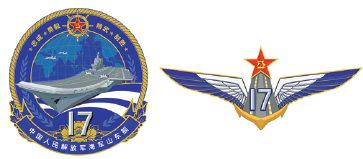
The emblem and logo of the Shandong. [Photo/China Daily]
"From the choice of fabrics for the caps to the detailing on the building blocks, each decision was made to present the quality of the 'made in China' brand," Xie says.
"In the future, we want to design new cultural and creative products about the Shandong so that people from different ages with different hobbies can get a feel for military culture."
Wang Yan, head of the China Institute of Marine Technology and Economy, says the design and release of the cultural and creative products of the Shandong will help to promote nautical and aeronautic culture in China.
The China State Shipbuilding Corp donated a selection of their products related to the Shandong to the Military Museum of the Chinese People's Revolution in Beijing on Jan 7.
He Qinglin, deputy chief designer of the Shandong, says that while his designs revolved more around engineering, Xie's designs were focused on art. He says the design of the Shandong's emblem and logo, and its cultural and creative products embrace the vitality of the ship.
"These cultural designs and products will help ordinary people to learn about China's first homegrown aircraft carrier," He says.








